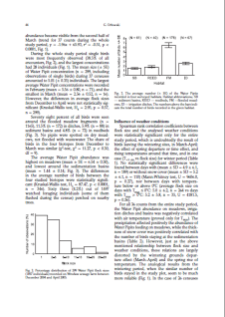- Search in all Repository
- Literature and maps
- Archeology
- Mills database
- Natural sciences
Advanced search
Advanced search
Advanced search
Advanced search
Advanced search

Object
Title: Species Richness of Breeding Birds at a Landscape Scale: Which Habitat Type is the Most Important?
Subtitle:
Który rodzaj siedlisk ma największy wpływ na bogactwo gatunkowe ptaków lęgowych w skalikrajobrazu? ; Habitat type and bird species richness
Contributor:
Museum and Institute of Zoology, Polish Academy of Sciences
Publisher:
Museum and Institute of Zoology, Polish Academy of Sciences
Place of publishing:
Description:
Type of object:
Abstract:
The aim of the study was to compare different habitat types according to species richness and estimate their value for total species richness at a landscape level. The study was carried out in the years 1995–2001 in the Tarnów region (1400 km2, S Poland). All bird species were classified according to broadly defined breeding habitat type. Four main, easily distinguishable habitat types were specified: forests (18% of the area), open areas (70%), wetlands (1%) and anthropogenic areas (11%). Birds were classified as habitat specialists if they bred in only one habitat type, or as habitat generalists, if they bred in two or more habitat types. Altogether, 151 species nested in the study area, and a total of 87 species were habitat specialists. There were statistically more endangered species (so called “losers”) among the habitat specialists than in the habitat generalists' group. Habitat specialists were also statistically less abundant than habitat generalists. The following numbers of species were recorded in the specific habitats: forests — 70, open areas — 75, wetlands — 61, anthropogenic areas — 46. Among these, the percentages of habitat specialists were the following: forests — 41.4%, open areas — 18.7%, wetlands — 52.5%, anthropogenic areas — 26.1%. It was found that the numbers of species inhabiting the various habitat types differed from the number to be expected on the basis of their area. This was especially apparent in the case of wetlands, which constituted only a small part of the total area, but as many as 32 species (21.1% of all) occurred only there. For conservation purposes, wetlands appear to play the most important role in shaping species richness in the landscape studied here. However, each habitat type contained some species that were not noted in other habitats.
Relation:
Volume:
Issue:
Start page:
End page:
Detailed Resource Type:
Format:
Resource Identifier:
oai:rcin.org.pl:55564 ; 10.3161/068.041.0111
Source:
MiIZ PAN, sygn. P.4568 ; MiIZ PAN, sygn. P.257 ; click here to follow the link
Language:
Language of abstract:
Rights:
Prawa zastrzeżone - dostęp ograniczony
Terms of use:
Digitizing institution:
Muzeum i Instytut Zoologii Polskiej Akademii Nauk
Original in:
Biblioteka Muzeum i Instytutu Zoologii PAN
Access:
Object collections:
- Digital Repository of Scientific Institutes > Partners' collections > Museum and Institute of Zoology PAS > Scientific Journals
- Digital Repository of Scientific Institutes > Partners' collections > Museum and Institute of Zoology PAS > MIZ PAN Publications > Acta Ornithologica
- Digital Repository of Scientific Institutes > Literature > Journals/Articles
Last modified:
Aug 8, 2023
In our library since:
Jul 29, 2015
Number of object content downloads / hits:
9
All available object's versions:
https://rcin.org.pl./publication/75745
Show description in RDF format:
Show description in RDFa format:
Show description in OAI-PMH format:
Objects Similar
Skórka, Piotr Martyka, Rafał Wójcik, Joanna D Babiarz, Tomasz Skórka, Janusz
Martyka, Rafał Skórka, Piotr
Martyka, Rafał Skórka, Piotr
Jermaczek, Andrzej (1957– )
Fog, Jørgen (1933– )
Dobrowolski, Kazimierz A.
Murgui, Enrique

 INSTYTUT ARCHEOLOGII I ETNOLOGII POLSKIEJ AKADEMII NAUK
INSTYTUT ARCHEOLOGII I ETNOLOGII POLSKIEJ AKADEMII NAUK
 INSTYTUT BADAŃ LITERACKICH POLSKIEJ AKADEMII NAUK
INSTYTUT BADAŃ LITERACKICH POLSKIEJ AKADEMII NAUK
 INSTYTUT BADAWCZY LEŚNICTWA
INSTYTUT BADAWCZY LEŚNICTWA
 INSTYTUT BIOLOGII DOŚWIADCZALNEJ IM. MARCELEGO NENCKIEGO POLSKIEJ AKADEMII NAUK
INSTYTUT BIOLOGII DOŚWIADCZALNEJ IM. MARCELEGO NENCKIEGO POLSKIEJ AKADEMII NAUK
 INSTYTUT BIOLOGII SSAKÓW POLSKIEJ AKADEMII NAUK
INSTYTUT BIOLOGII SSAKÓW POLSKIEJ AKADEMII NAUK
 INSTYTUT CHEMII FIZYCZNEJ PAN
INSTYTUT CHEMII FIZYCZNEJ PAN
 INSTYTUT CHEMII ORGANICZNEJ PAN
INSTYTUT CHEMII ORGANICZNEJ PAN
 INSTYTUT FILOZOFII I SOCJOLOGII PAN
INSTYTUT FILOZOFII I SOCJOLOGII PAN
 INSTYTUT GEOGRAFII I PRZESTRZENNEGO ZAGOSPODAROWANIA PAN
INSTYTUT GEOGRAFII I PRZESTRZENNEGO ZAGOSPODAROWANIA PAN
 INSTYTUT HISTORII im. TADEUSZA MANTEUFFLA POLSKIEJ AKADEMII NAUK
INSTYTUT HISTORII im. TADEUSZA MANTEUFFLA POLSKIEJ AKADEMII NAUK
 INSTYTUT JĘZYKA POLSKIEGO POLSKIEJ AKADEMII NAUK
INSTYTUT JĘZYKA POLSKIEGO POLSKIEJ AKADEMII NAUK
 INSTYTUT MATEMATYCZNY PAN
INSTYTUT MATEMATYCZNY PAN
 INSTYTUT MEDYCYNY DOŚWIADCZALNEJ I KLINICZNEJ IM.MIROSŁAWA MOSSAKOWSKIEGO POLSKIEJ AKADEMII NAUK
INSTYTUT MEDYCYNY DOŚWIADCZALNEJ I KLINICZNEJ IM.MIROSŁAWA MOSSAKOWSKIEGO POLSKIEJ AKADEMII NAUK
 INSTYTUT PODSTAWOWYCH PROBLEMÓW TECHNIKI PAN
INSTYTUT PODSTAWOWYCH PROBLEMÓW TECHNIKI PAN
 INSTYTUT SLAWISTYKI PAN
INSTYTUT SLAWISTYKI PAN
 SIEĆ BADAWCZA ŁUKASIEWICZ - INSTYTUT TECHNOLOGII MATERIAŁÓW ELEKTRONICZNYCH
SIEĆ BADAWCZA ŁUKASIEWICZ - INSTYTUT TECHNOLOGII MATERIAŁÓW ELEKTRONICZNYCH
 MUZEUM I INSTYTUT ZOOLOGII POLSKIEJ AKADEMII NAUK
MUZEUM I INSTYTUT ZOOLOGII POLSKIEJ AKADEMII NAUK
 INSTYTUT BADAŃ SYSTEMOWYCH PAN
INSTYTUT BADAŃ SYSTEMOWYCH PAN
 INSTYTUT BOTANIKI IM. WŁADYSŁAWA SZAFERA POLSKIEJ AKADEMII NAUK
INSTYTUT BOTANIKI IM. WŁADYSŁAWA SZAFERA POLSKIEJ AKADEMII NAUK


































